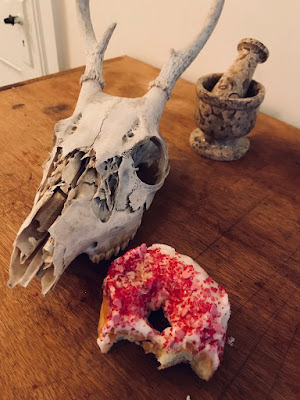This is not something recent. Doughnuts have been popular here for centuries. As Keith Stavely and Kathleen Fitzgerald discuss in their 2015 book America's Founding Food, early New Englanders ate doughnuts at almost any meal. They were particularly popular served with cheese and bread and butter during the break on Sunday church services. There's nothing like some fried sugary dough to get you through the next hour-long Calvinist sermon.
Of course, good church-going folks weren't the only people who loved doughnuts. They were popular with more disreputable people like sailors (many ships had doughnut making equipment in their galleys) and even witches.
That's right. Even witches liked doughnuts. And as the following Cape Cod legend demonstrates, witches became very unhappy when someone stole their doughnuts.
Way back in 1780, a sailor was walking through the dunes of Truro to reach a ship whose crew he was joining. It was a long hard walk through the sand and his stomach was beginning to rumble with hunger. As he passed by a small rundown house he smelled the rich aroma of freshly-made doughnuts wafting from within.
Unable to resist the smell he knocked on the door. No one answered. The door was unlocked so he opened it and stepped inside.
No one was home. Well, no one except a small black goat that sat by the fireplace. The sailor thought this was odd but he ignored the animal. His attention was captured by a tray of hot doughnuts cooling on the table. He couldn't resist. He grabbed the tray and ran out the door.
As he hurried away through the dunes he ate one doughnut and then another. They were the best doughnuts he had ever eaten.
By the time he reached the ship he had eaten all of them. Sure, he felt a little guilty for stealing someone's doughnuts, but they were only doughnuts, right? As the ship sailed away from the Cape he thought he would never be caught. He thought he had gotten away with the perfect doughnut crime.
He hadn't. That night as the sailor slept an old woman appeared to him. Angrily and without speaking a word she threw a horse's bridle over his head. The witch rode him up and down the Cape as he slept, digging her heels into his sides violently whenever he slowed his gait. In the morning his torso was covered in bruises shaped like a woman's shoe.
She appeared to him again the next night, and the next. He tried to hide the witch's nightly visitations from the other crew members. He knew that sailors were superstitious and wouldn't want someone cursed by a witch onboard. They'd call him a "Jonah" and try to throw him into the sea.
Unfortunately the witch's curse radiated out from him and everything he touched went wrong. After he was asked to pump the ship's drinking water it became brackish. When he was told to work in the ship's galley all the flour became moldy. He was exhausted, his body ached, and he was jinxed.
The crew began to mutter about him, and the ship's captain pulled him aside. "Tell me the truth," the captain said. "Are you bewitched?" The sailor told the captain everything: how he had stolen the doughnuts, how he was being ridden every night, and how he was now cursed.
When the sailor was done with his story the captain grabbed a musket and then pulled a silver button off his coat. He loaded the button into the musket and handed it to the sailor.
"Use this tonight when she comes for you," the captain said.
At midnight the crew was awakened by the sound of a single musket-shot. The next morning the sailor came up on the deck looking fresh and rested. The curse was lifted and the ship completed a successful voyage.
So there's the story. It sounds like a folktale to me, but some people claim it was true. The sailor eventually returned to Truro, and over a century later his grandson told the story to a reporter from The Boston Herald, where it appeared in the February 6, 1919 issue. The Harvard historian George Lyman Kittredge (author of 1929's Witchcraft in Old and New England) said he heard the same story from an old Truro native in the late 19th century. It is also included in Elizabeth Renard's book 1934 book The Narrow Land.
The doughnut angle is unusual, but like so many folktales about witches it is mainly intended to educate the hearer about how to fight back against witchcraft. The point is not that the sailor stole doughnuts, but that he was bewitched and defeated the witch. It's an education in defensive magic (use a silver bullet!), not a morality tale.
Still, I find the conclusion of this story troubling. Let's face it, the sailor committed a crime. I understand why the witch was so unhappy. I don't want anyone stealing my food, do you? Perhaps she should have gone to the local constable and pressed charges, but that might have raised some uncomfortable questions. ("Did you see the sailor steal your doughnuts ma'am?" "No, but my black goat familiar did...") Instead she took matters into her own hands. Perhaps the whole situation could have been defused if the sailor simply apologized or paid restitution.
Also, like a lot of New England witch stories there is an uncomfortable gender-dynamic at play. The nighttime witch-riding feels like it has a sexual subtext, and is something that is always used by female witches against male victims. But is the sailor really a victim in this story, or a perpetrator who needs to be punished?
*****
Special thanks to Tony for the doughnut photo shoot!

















